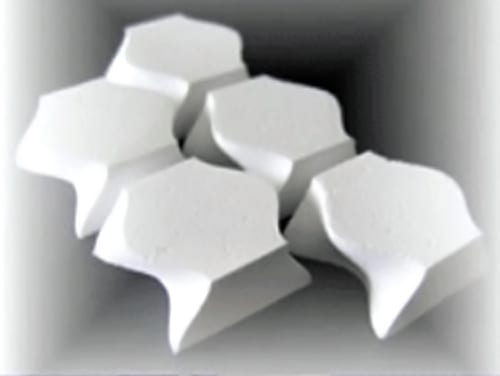For many high-temperature applications ceramics are indispensable. No other engineering materials offer such high stiffness, strength, hardness, and durability in the same package. The major difficulty in applying ceramic materials is their relatively low fracture toughness. Ceramic materials are generally vulnerable to tensile stresses and impact loading. Cracks propagate with high speed, which leads to sudden failure of ceramic components.
The use of segmented, rather than monolithic, structures is an appropriate way to cope with this low fracture toughness. Cracks that do occur remain confined within a single segment. The segments can be held together by a binder phase, keys, and connectors or by virtue of special geometry and arrangement of the segments.
 A group of researchers from the University of Bremen, Germany, the German Aerospace Center, and the Monash University in Clayton, Australia, studied the force-fit connection of discrete ceramic components by means of geometrically interlocking surfaces. These surfaces possess a concavo-convex topology permitting assembly of structures in which each individual element is kinematically locked by its neighbors.
A group of researchers from the University of Bremen, Germany, the German Aerospace Center, and the Monash University in Clayton, Australia, studied the force-fit connection of discrete ceramic components by means of geometrically interlocking surfaces. These surfaces possess a concavo-convex topology permitting assembly of structures in which each individual element is kinematically locked by its neighbors.
The researchers produced the elements by freeze gelation of ceramic slurries, which enable a near net shape and a low shrinkage. The freeze gelation process (FGP) involves rapid freezing of colloidal dispersed slurries containing ceramic particles and subsequent drying and sintering. This method is cost-effective and offers many possibilities to control the production of ceramic parts.
For comparison, the group tested solid plates of the same ceramic material in the same loading mode. During loading, the planar surfaces within the interlocked structure lose contact to their neighbors. But the concavo-convex surfaces remain in contact. Cracks are localized within individual blocks. As no binder phase connects the constituent blocks, the weakest link principle does not fully apply to an interlocked structure. Thus, these structures allow for large deformations and are tolerant to missing or destroyed elements.
However, the solid plate could not withstand deformation beyond the point of maximum load, the segmented ones were able to maintain their structural integrity and stay deformable well beyond the point of maximum load. The assemblies of interlocked ceramic elements can withstand flexural deflections up to a ten-fold of those the solid plate from the same material can sustain.














